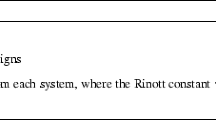Abstract
We consider the spatial sampling design problem for a random field X. This random field is in general assumed not to be directly observable, but sample information from a related variable Y is available. Our purpose in this paper is to present a state-space model approach to network design based on Shannon's definition of entropy, and describe its main points with regard to some of the most common practical problems in spatial sampling design. For applications, an adaptation of Ko et al.'s (1995) algorithm for maximum entropy sampling in this context is provided. We illustrate the methodology using piezometric data from the Velez aquifer (Malaga, Spain). © Rapid Science 1998
Similar content being viewed by others
References
Angulo, J.M., Azari, A.S., Shumway, R.H., and Yucel, Z.T. (1994) Fourier approximations for estimation and smoothing of irregularly observed spatial processes. Stochastic and Statistical Methods in Hydrology and Environmental Engineering, 2, 353–65.
Aspie, D. and Barnes, R.J. (1990) Infill-sampling design and the cost of classification errors. Mathematical Geology, 22(8), 915–32.
Bogárdi, I., Bárdossy, A., and Duckstein, L. (1985) Multicriterion network design using geostatistics. Water Resources Research, 21(2), 199–208.
Bras, R.L. and Rodríguez-Iturbe, I. (1976) Network design for the estimation of a real mean of rainfall events. Water Resources Research, 12(6), 1185–95.
Caselton, W.F. and Hussian, T. (1980) Hydrologic networks: Information transmission. Journal of the Water Resources Planning and Management Division, A.S.C.E., 106 (WR2), 503–20.
Caselton, W.F., Kan, L., and Zidek, J.V. (1991) Quality data network designs based on entropy. In Statistics in the Environmental and Earth Sciences, P. Guttorp and A. Walden (eds), Griffin, London.
Caselton, W.F. and Zidek, J.V. (1984) Optimal monitoring network designs. Statistics and Probability Letters, 2, 223–7.
Christakos, G. (1992) Random Field Models in Earth Sciences. Academic Press, San Diego.
Cressie, N.A.C. (1991) Statistics for Spatial Data. Wiley, New York.
De Gruijter, J.J. and Ter Braak, C.J.F. (1990) Model-free estimation from spatial samples: A reappraisal of classical sampling theory. Mathematical Geology, 22(4), 407–15.
Guttorp, P., Le, N.D., Sampson, P.D., and Zidek, J.V. (1993) Using entropy in the redesign of an environmental monitoring network. In Multivariate Environmental Statistics, G.P. Patil and C.R. Rao (eds), Elsevier, New York pp. 175–202.
Haas, T.C. (1992) Redesigning continental-scale monitoring networks. Atmospheric Environment, 26A, 18, 3323–33.
Jones, R.H. (1989) Fitting a stochastic partial differential equation to aquifer data. Stochastic Hydrology and Hydraulics, 3, 85–96.
Jones, R.H. and Vecchia, A.V. (1993) Fitting continuous ARMA models to unequally spaced spatial data. Journal of the American Statistical Association, 88, 947–54.
Journel, A.G. (1994) Resampling from stochastic simulations. Environmental and Ecological Statistics, 1, 63–91.
Ko, C.-W., Lee, J., and Queyranne, M. (1995) An exact algorithm for maximum entropy sampling. Operations Research, 43, 684–91.
Mardia, K.V. and Goodall, C.R. (1993) Spatial-temporal analysis of multivariate environmental monitoring data. In Multivariate Environmental Statistics, G.P. Patil and C.R. Rao (eds), Elsevier, New York, pp. 347–86.
Samper, F.J. and Carrera, J. (1990) Geoestadística. Aplicaciones a la hidrogeología subterránea. Gráficas Torres, Barcelona.
Shannon, C.E. (1948) A mathematical theory of communication. Bell System Technical Journal, 27, 379–423.
Trujillo-Ventura, A. and Ellis, J.H. (1991) Multiobjective air pollution monitoring network design. Atmospheric Environment, 25A(2), 469–79.
Vecchia, A.V. (1988) Estimation and model identification for continuous spatial processes. Journal of the Royal Statistical Society B, 50, 292–312.
Whittle, P. (1954) On stationary processes in the plane. Biometrika, 41, 434–49.
Wu, S. and Zidek, J.V. (1992) An entropy-based analysis of data from selected NADP/NTN network sites for 1983–1986. Atmospheric Environment, 26A(11), 2089–103.
Author information
Authors and Affiliations
Rights and permissions
About this article
Cite this article
Bueso, M.C., Angulo, J.M. & Alonso, F.J. A state-space model approach to optimum spatial sampling design based on entropy. Environmental and Ecological Statistics 5, 29–44 (1998). https://doi.org/10.1023/A:1009603318668
Issue Date:
DOI: https://doi.org/10.1023/A:1009603318668




